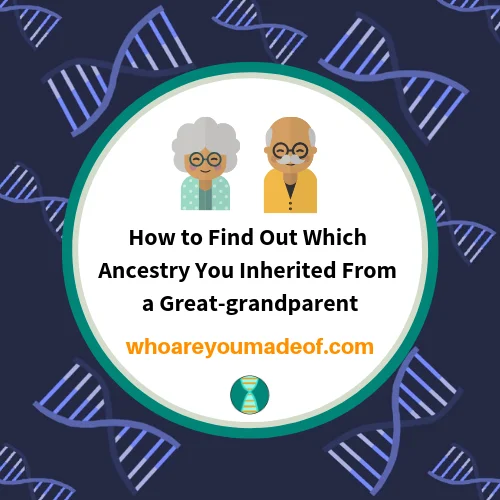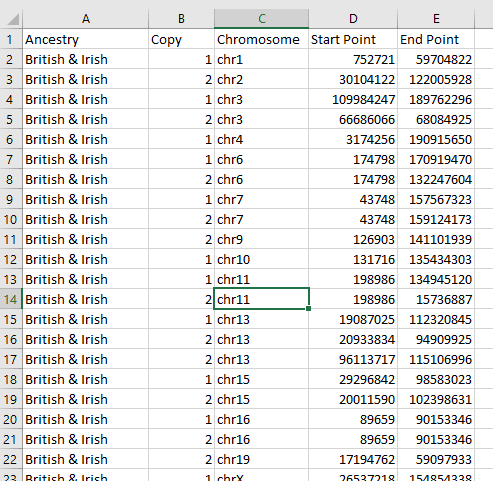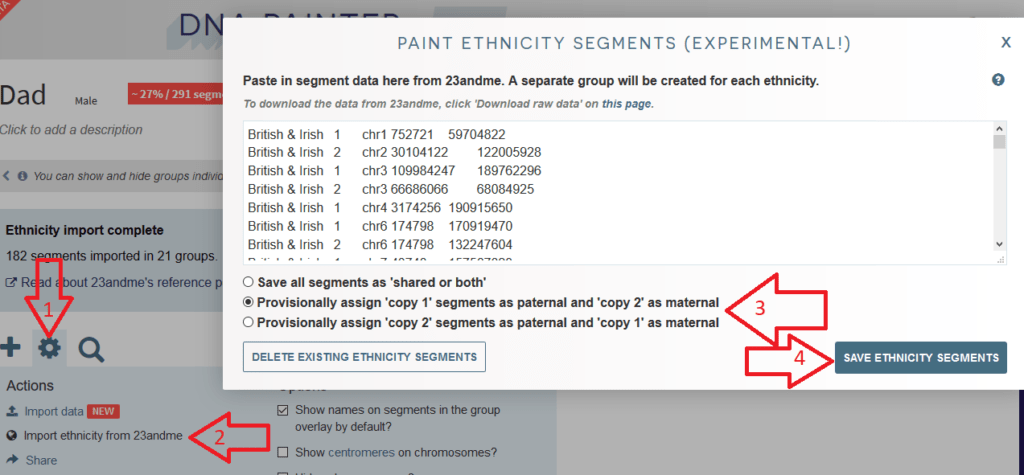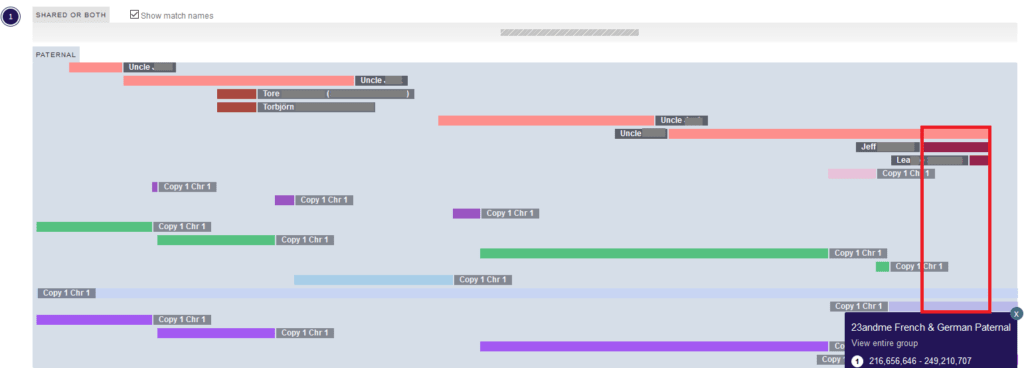If you have taken a DNA test, you might wonder if you can figure out which ancestry regions you inherited from your recent ancestors. There is a way to determine which ethnicity or ancestry regions you likely inherited from your grandparents, great-grandparents, and even great-great grandparents. In this post, I'll teach you how to do it.

Why try to determine the ethnicity of a great-grandparent?
If you've never thought about which ancestor passed down your ancestry regions to you, you might wonder why people would even want to know this information. There are lots of reasons why you might want to try to figure out which regions in your ethnicity estimate came from a particular ancestor.
For example, I was recently contacted by a friend who was curious about how they might go about identifying the ethnicity of their great-grandparent. They had grown up hearing family stories about their great-grandparent who lived on a Native American reservation in Wisconsin, and genealogy research had determined that his ancestor was born there.
His main question was was whether there was a way to see if his Native American DNA was inherited from that particular great-grandparent, or another line of his tree.
In my own family tree, I was interested in learning more about the ancestry of my dad's paternal grandmother. By using the process outlined below, I was able to determine which ancestry regions I likely inherited from her, as well as more details about her probable ethnicity.
Take a 23andMe DNA test to learn about your grandparent's ancestry
My first DNA test wasn't with 23andMe. After a year or so exploring (and enjoying!) my Ancestry DNA results, I learned that 23andMe allows users to download segment data corresponding to their ancestry composition report.
I would be able to see the exact locations on my chromosomes where my ancestry regions were detected, and I could cross-reference this information with DNA segments shared with my DNA matches to determine which regions I may have inherited from my dad's grandmother.
This segment data, along with the knowledge that I would be able to see my DNA matches and use the chromosome browser on 23andMe, was reason enough to get DNA tests on 23andMe for me and both of my parents.
As of right now, there is no other DNA testing company that allows you detailed access your ethnicity or ancestry data by segment, with the exception of the Ancestry test that can allow you to isolate the general regions that you inherited from each parent.
In order to access the data that you need to isolate which ancestry regions you inherited from a particular ancestor, you will need access to more detailed chromosome data, including the exact start and stop positions of DNA segments matching each region reported on your results. This is exactly the type of information that we can access with the 23andMe test.
Fortunately, my parents and I got our 23andMe results back very quickly. Below, I show you a few examples as I go along in this post.
You'll also learn how you can apply to same method to your 23andMe DNA results to learn more about a particular ancestor who interests you, or see who passed down your ancestry regions.
You can get your 23andMe test using the following link, if you want to get started learning more detail about your ancestry/ethnicity regions. If you use the link below, I might get a very small commission at no extra cost to you and it helps me support the education that I do on this website - so thanks!
Download your ethnicity data from 23andMe
Once you get your DNA results back, or if you have already done a DNA test with 23andMe, you'll need to download your ethnicity data from 23andMe. It's easy to do - don't worry!
It is important to note that this is not the same data as your downloaded DNA file.
Follow the instructions that I describe on this post:
Import your ethnicity data to DNA Painter
Now that you have your segment data, you can open the file. My dad's file looks something like the image below. I opened it up in Excel.

You might notice the column that says "Copy", and that there are only 1's and 2's in that column. This is because we have two copies of each chromosome.
We inherit one copy from each of our parents that is "recombined" to include DNA from both of their parents (i.e. our grandparents). This is important information to know, as you'll see below.
While you could, in theory, be organized enough to make a spreadsheet to use this data to find segments that overlap with your DNA matches, there is a way to do it that is MUCH easier and actually kind of fun.
I use a website called DNA Painter. It's free to begin to use, and you can easily import the data from your downloaded file from 23andMe into your profile on this website in order to begin to understand which ethnicity segments came from which ancestors.
Remember how I mentioned above that we have two copies of each chromosome? When you import your ethnicity segment data into DNA Painter, you will need to specify whether you would like to assign copy 1 as paternal and copy 2 as maternal, or vice versa.
The image below shows the steps that you need to take from within DNA Painter (in order) to import your ethnicity segment data:

You can pick any option you'd like. For starters, you can assign copy 1 to your dad and copy 2 to your mom, and if you decide that it should reversed later, you can always switch it. If your parents have some shared ancestry, it might not be easy to decide until you've painted in several DNA matches (see below).
Note: Some people have reported that copy 1 and copy 2 could be paternal/ maternal on one chromosome and maternal/paternal on another chromosome - or that it can even be different for each chromosome. This just something to look out for.
Paint in your closest matches to DNA Painter to find segments inherited from your great-grandparents
Now that you have pasted your segment data into your DNA Painter profile, you should begin the process of "painting" as many of your close DNA matches into the site as you can. You could start with aunts, uncles, cousins, grandparents, second cousins, etc.
Important! Only "paint" DNA matches that have a known connection to you. In other words, if you don't know the most recent common ancestor you share with your match, don't paint them into your DNA Painter profile. Once you learn your connection, you can paint them in.
Follow the instructions on this post about how to paint your first match:
You should paint as many matches as you can, starting with your closest matches (just don't paint in your parents). As you paint in more matches, you will notice that some of the DNA segments that you share with your genetic relatives overlap, or match with, those ethnicity segments that you pasted in from 23andMe.
This might be where you are able to figure out that the first copy of your chromosomes is paternal and the second is paternal. For example,
Since you have only painted in those matches with whom you share a known connection, you should now be able begin to see how useful this process will become to you.
Examine overlapping DNA match and ethnicity segments
Even though I still have a lot of work to do to "paint" in more matches to my DNA Painter profile, I have some of the information that I was looking for. For example, I found that my dad's paternal grandmother likely had some French and German ancestry.
I know this because of one of my DNA matches. We share a segment on my paternal copy of Chromosome 1, which happens to overlap with a German/French segment detected by 23andMe:

In the image above, I highlighted the overlapping segments by drawing a red rectangle around them. The grey segment towards the bottom is the French/German ethnicity segment, and the maroon and pink segments are from three of my DNA matches who are descended from a particular line of my dad's grandmother's family tree.
I have lots of other DNA matches that share segments that overlap with my ethnicity data, and by examining these segments one by one, I can determine with some confidence (of course, not 100% confidence!) which ethnicity regions I probably inherited from my great-grandmother.
While this does not provide me with complete information about my great-grandmother's heritage, it does tell me that these particular ancestors passed down French and German DNA to my great-grandmother. It could also tell me where to focus my research efforts, if I were facing conflicting genealogical information.
As you can see, this method takes a lot of attention to detail, and significant effort. Along the way, while working towards identifying the ancestry of your research target, you are sure to learn a lot of interesting information about your family tree and DNA relatives.
By combining this information with information obtained through other means (DNA matches, genealogical research), I can learn a lot about my great-grandmother and her ancestors.
Conclusion
I hope that this post has helped you understand which ethnicity or ancestry you inherited from your great-grandparent (or all of your great-grandparents!). If you have any questions, or have tried this process yourself, I would love to hear from you in the comments below.
Thanks for stopping by!


Tiffany
Tuesday 4th of August 2020
Regarding DNA painter, I’ve found that some DNA matches on my paternal side partially overlap with matches on my maternal side. However, when I used the ‘Are your parents related’ GED match tool, thankfully it revealed that they are not. What does this mean?
Tiffany
Mercedes
Monday 10th of August 2020
Hi Tiffany, Thank you for your excellent question! What you are seeing in DNA Painter is the result of every person having TWO copies of each chromosome. When you paint in a new match, if you have both paternal and maternal matches that match at similar locations, you will find that the program will tell you that your match overlaps with both sides of your family. This is, of course, until you tell DNA Painter which side of the family the match is on. In other words, you are telling DNA Painter which copy of the chromosome that your match matches you on. This is the most likely explanation for what you are experiencing, and it doesn't mean that your parents are related. I hope that this helps!! Mercedes
Barbara Blunt
Tuesday 2nd of June 2020
Just a quick question. Do you have to have both of your parents do the 23andme test?
Mercedes
Tuesday 2nd of June 2020
Hi Barbara, If you have the opportunity to have both of your parents test, then I would highly recommend it. If only one of your parents can do the test, it is still helpful. Best of luck!! Mercedes